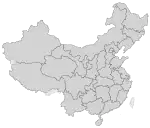History of Chongqing
Prehistory
Evidence of human activity in Chongqing has been discovered dating back to the Old Stone Age, approximately 20–30,000 years ago.[1] The fossils of a lower jawbone and teeth of an extinct non-hominin ape discovered near Wushan County in 1985 was originally thought to be a 2-million-year-old primitive human known as Wushan Man. This theory, originally proposed by Russell Ciochon, was reversed by the same scientist 15 years later – as it would void the "Out of Africa" hypothesis.[2]
Pre-unification
At the beginning of the Zhou dynasty in the 11th century BC, the State of Ba was formed by the population of eastern Sichuan. However, this was not more than a loose confederation of independent clans who recognised a single king. During the Warring States period, the State of Ba fell into decline, until it was absorbed by the State of Qin in 316 BCE. It is unknown why the State of Ba fell so quickly into decline, but it is thought that due to a lack of a sense of real unity, a powerful army could not be raised, leaving it open to attack by invaders.[3]
Imperial history
At different times throughout its history, Chongqing was known by several different names, including Jiangzhou, Ba Prefecture, Chu Prefecture (420–581), Yu Prefecture and Gong Prefecture (during the Northern Song Dynasty). In 1189, the area was renamed Chongqing Fu by Emperor Guangzong (then called Prince Gong).[1][4] Chongqing (literally, 'redoubled celebration') was renamed as such by Emperor Guangzong as he was promoted from the ruler of a Zhou to a Fu (area of special importance) and also promoted from the position of a Prince to Emperor Guangzong of the Song Dynasty in the very same year, hence the term 'redoubled celebration'.[5]
The Ming and Qing dynasties saw a period of rapid economic growth for the city as merchants gathered there from all over China. In 1891, the city's port was made open to the outside world, and a customs house was set up. In 1929, Chongqing was formally declared a city.[4]
Modern times
After the outbreak of the Second Sino-Japanese War in 1937, the Kuomintang moved its seat of government from Nanjing to Chongqing. In 1939 the city was made a municipality under the Executive Yuan and in 1940 was made the provisional wartime capital of China. Chongqing endured years of intensive daytime and nighttime bombings by massed formations of Imperial Japanese Naval and Army Air Forces in the Battles of Chongqing and Chengdu; battles of which were fought entirely by opposing air forces and anti-aircraft defenses.[6][7][8] In 1946, the seat of government was again moved, this time back to Nanjing. After the founding of the People's Republic of China in 1949, Chongqing remained the cultural and economic centre of southwestern China. In 1983, the economic reforms effected by Paramount Leader Deng Xiaoping were trialled in the city.[4] In 1997 Chongqing became the one of four municipalities directly under the central government in China, and the only one in western China.[1]
See also
References
- History of Chongqing Archived 2010-08-10 at the Wayback Machine – Chongqing Municipal Government (accessed 2010-01-10).
- ^ Handwerk B. (2009). Early "Human" Is Ape After All, Discoverer Decides National Geographic News June 17, 2009
- Three Gorges Archaeology: Mysteries of the Ancient Ba People Archived 2011-07-08 at the Wayback Machine, CNHubei.com, 17 September 2008 (accessed 2010-01-10).
- History of Chongqing, China Today Tours (accessed 2010-01-10).
- History of Chongqing, Green Travel (accessed 2010-01-10).
- 红岩, 春秋. "45架日机临空,80年前"5•3"重庆大空战,到底有多激烈? - 上游新闻·汇聚向上的力量 - Revisiting that first major air battle over Chongqing; 03 May 1939". www.cqcb.com. Retrieved 2020-11-15.
这是一场中方资料记载缺失的空战,却载入了日本防卫厅防卫研修所战史室编著的《战史丛书》。
- Chai, George. "五三重庆空战". www.flyingtiger-cacw.com. Retrieved 2020-11-15.
日大本营下达轰炸中国大后方的《陆海军中央协定》,以“加速瓦解敌政权”。这次行动的代号定为“101号作战”。参战的日陆军航空队由木下敏中将指挥,主要基地在山西运城;海军航空队由山口多闻少将指挥,主要基地在汉口。日陆海军共出动4555架次,投弹27107枚,其中对重庆空袭2023架次,投弹10021枚。“101号作战”历时110天,是日军对重庆最大规模的空中作战。
- Du, Wenwen. "揭秘重庆空战:抗战期间出动飞机2159次 - 中国军网". www.chinamil.com.cn. Retrieved 2020-11-15.
揭秘重庆空战:抗战期间出动飞机2159次
